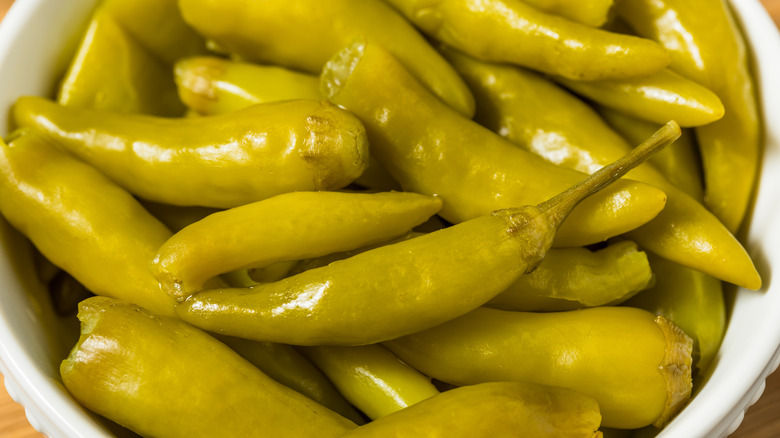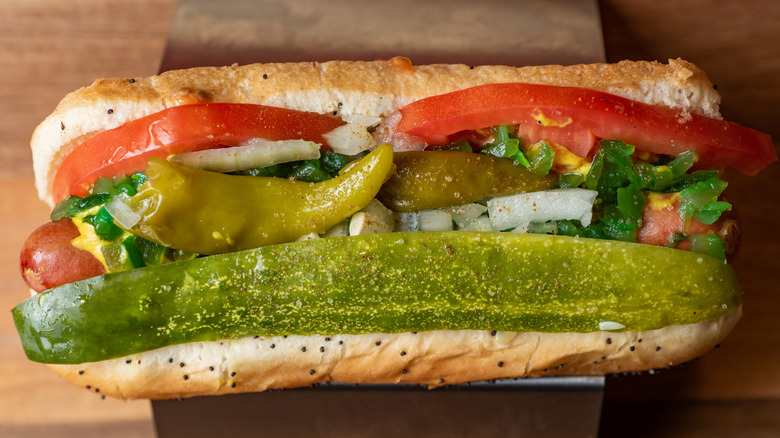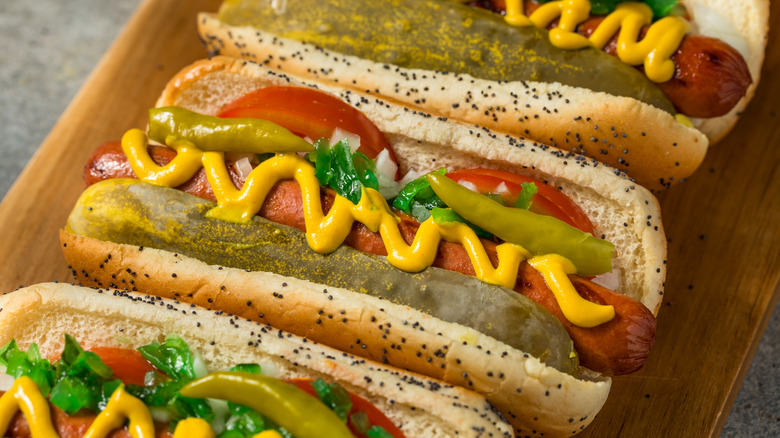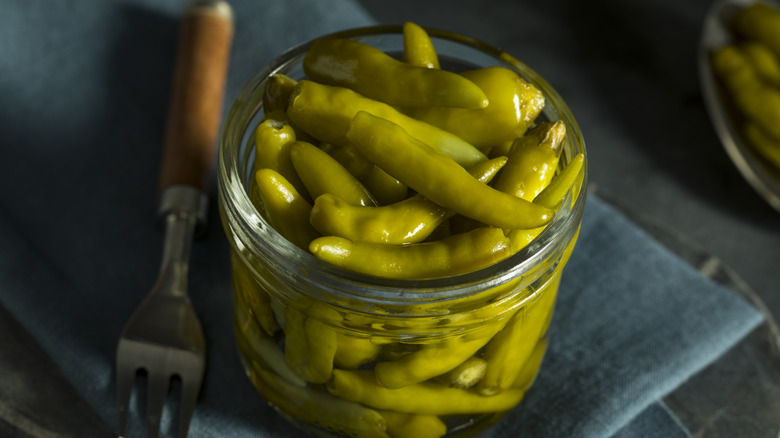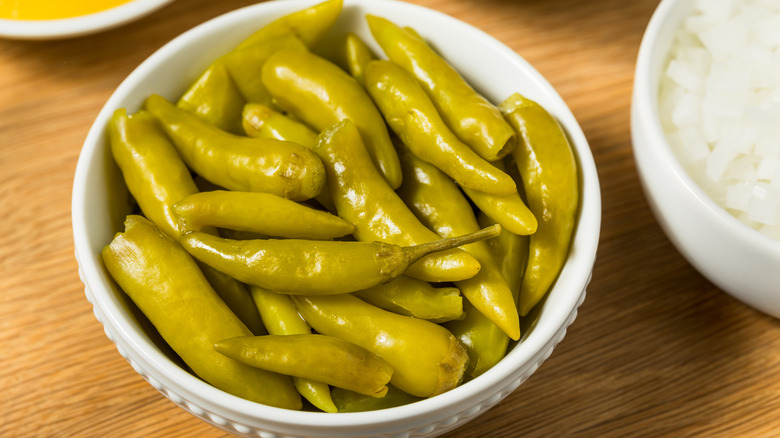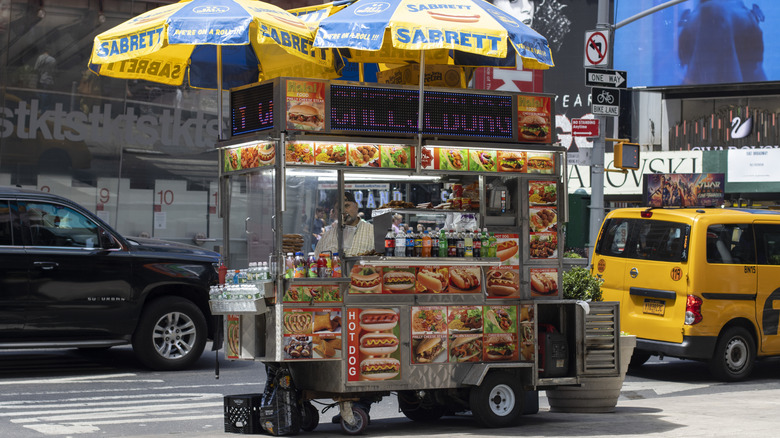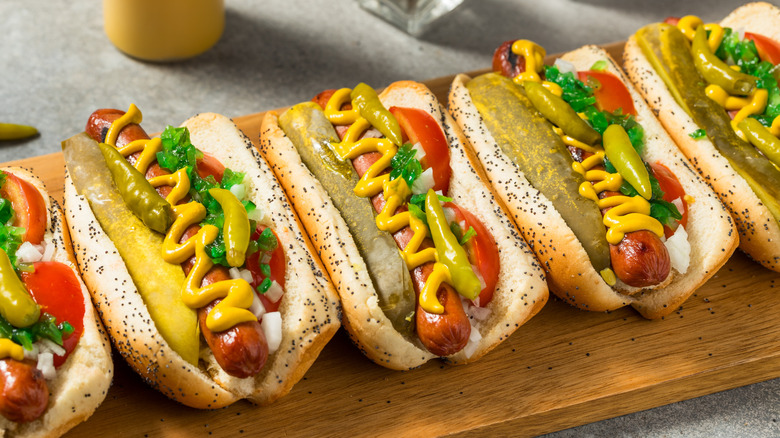Chicago's Favorite Hot Pepper, The Sport Pepper, Explained
Every Chicagoan can pretty much recite the toppings to a Chicago-style hot dog by memory: yellow mustard, diced onions, tomato slices, neon green relish, a pickle spear, sport peppers, and a dash of celery salt. It's a lot, but in concert, there's nothing like this vibrant combination of condiments on a steamed hot dog.
All of these ingredients are more or less readily available in every grocery store across the United States, save one of them: sport peppers. So, what the heck is a sport pepper?
What do sport peppers look and taste like?
Sport peppers grace the shelves at almost every grocery store around Chicago, but once you leave the area, they're practically nonexistent across the rest of the country. They're small and thin, roughly half the length of a pinky finger, with a distinct tapered pointy end, and they always come pickled in glass jars.
These little guys are vinegary and briny, and usually hover around a medium-level heat, though they can vary a bit sometimes. (I've had a couple unexpectedly hot ones.) My favorite part about them is that their vegetal bite functions sort of like a built-in palate cleanser, preparing you for the next bite of hot dog.
Are sport peppers only used on hot dogs?
I've never once seen a fresh sport pepper. Ever. In my mind, the closest fresh pepper you can readily purchase is a serrano. However, in my experience, serranos can be larger and much spicier than a sport pepper, and their shape is slightly different. Part of me has long suspected that sport peppers are really just a sub-variety of pickled serranos, and that the pickling process tempers their sharp heat. (I was wrong about that — we'll get into it later.)
And as for their uses, they're downright sacred, exclusively used to top hot dogs and polish sausages. (While I do snack on them sometimes with a sandwich at home, I don't think this is commonplace.) The fact that sport peppers seem to serve one and only one purpose has always seemed curious to me, so I contacted Vienna Beef, the manufacturer of almost all the hot dogs you'll see at Chicago-area stands.
Tom McGlade, senior vice president of marketing and e-commerce for Vienna Beef, helped shed some light on the humble yet fascinating sport pepper.
Sport peppers are hard to come by
The Takeout: What does your role at Vienna Beef entail?
Tom McGlade: We do all the promotions, advertising, packaging, that's all my department. And I oversee our e-commerce department, viennabeef.com, which you can buy sport peppers on (or Amazon, or Goldbelly, or Tastes of Chicago).
Oddly enough, sport peppers are among the top three selling items on our online business. You would think hot dogs would be the number one item, but believe it or not, sport peppers, bright green relish, and giardiniera are our top three.
TO: I'm assuming if sport peppers are in the top three online selling items, many people can't find them at their local stores.
TM: Exactly. You can't find bright green relish in the store outside of Chicago. You can't find sport peppers outside of Chicago. You can't find giardiniera outside of Chicago. There's a handful of manufacturers that do giardiniera, there's hardly any that do sport peppers, and hardly any that do bright green relish, especially in a consumer-friendly bottle.
We sell a 12-oz. jar to retail [stores] and online. But we sell five-gallon pails of all of those ingredients to hot dog stands. Add celery salt to the mix, and those are pretty unique to either a [Italian] beef sandwich or a Chicago-style hot dog.
What is a sport pepper?
TO: What exactly is a sport pepper?
TM: A sport pepper is actually a sport pepper. It can sometimes be confused with a serrano pepper, and it's very similar to what I would call a small serrano pepper, but the variety is actually called a "Mississippi sport pepper." It is actually a thing. A small serrano pepper could be really close to it.
Now, where they're grown is obviously Mississippi, [plus] Texas and Mexico. We buy the seed variety and then the growers plant it for us, and this is the best part: Vienna is the biggest buyer of Mississippi sport peppers in the world. We go through the most because of our hot dog. On a Chicago-style hot dog, the crown jewel is the sport pepper.
We only buy our sport peppers from Mexico. Our grower is so good at it. He specs it out so perfectly that we have kind of partnered with one guy, who obviously loves us as a customer, because of our volume. (And vice versa.)
Why don't people outside of Chicago eat sport peppers?
TO: People don't seem to eat sport peppers outside of Chicago. Do you know why?
TM: Transplanted Chicagoans do, because they're used to them. They grew up eating it. It's just like any regional food — you know, why don't people outside of Philadelphia eat a Philly cheesesteak every day? Because that's not what they grew up on. Or, why do people in Omaha not have deep-dish pizza stands everywhere? The regionality of foods dictate what people like and are used to.
When you grow up on a food, in my opinion, you become acclimated to it and it becomes more than just food, it kind of becomes a memory. Let's say your grandfather, when you were a kid, takes you to a hot dog stand and says, "let's get a Chicago-style hot dog, a tamale, and a Green River drink." That to me is kind of an impression builder, and creates a kind of aura and a mystique around the whole eating experience.
So let's just say you move to Phoenix, Arizona, and you crave a Chicago dog. So many people move to Arizona that Arizona's actually a really good market for us. It's our second biggest market outside of Chicago. Phoenix and Scottsdale. Because of the transplanted Chicagoans that go there to retire, or vacation (the Cubs and the Sox play spring ball there), there's just a whole Chicago-and-West thing going on.
It's the same with Florida, same with Texas, same with California — there's so many expats from Chicago that move to those locations that it becomes a mini culture in pockets of the world. There's consumers in Tampa that lived in Chicago that don't want to go to a hot dog stand every time. They can go online and buy it, and get all the things to make a Chicago authentic hot dog in their backyard.
That's where our e-commerce comes into play. We do over two million dollars of online business per year, selling foods outside of Chicago to ex-Chicagoans.
Sport peppers bring a unique flavor to hot dogs
TO: To me, a sport pepper is the identity of a Chicago hot dog. It's funny that these came to be part of the hot dog, because that's such a particular crop.
TM: In the 1930s or '40s when the Chicago-style hot dog became popular, that was probably the pepper somebody had. The way the Chicago hot dog developed, on Maxwell street, was like a melting pot of different ethnic neighborhoods and ethnicities. Those immigrants had their favorite condiments that they liked putting on a hot dog. Each contributed their own kind of topping to the hot dog, which ended up being what we call the "seven sacred condiments."
And where that pepper first showed up was probably some guy's produce cart. Now it becomes a thing that's super important to a character and a makeup of a Chicago dog.
You can get a kosher pickle, onion, tomato, and yellow mustard anywhere. The crown jewel really is the sport pepper. I say the "secret sauce" is the celery salt — people don't realize how much flavor that adds. And the uniqueness of the green relish, being bright green. If you had regular relish and a Greek pepper on a hot dog, people will say, "What in the world is this?" And they'd hand it back to the operator, because they'd say it's not authentic.
